Picking the best comforter can make all the difference when it comes to one’s sleep quality. Finding the perfect warmth, loft and filling can ensure one gets a long, deep sleep. While most people prefer something warm and fluffy, that feeling is not for everyone. There are many types of sleepers and many types of comforters. This can make the buying process quite overwhelming.
Fear not. I have eight comforters here that are tailored for different sleep needs and preferences. Read on to find out about the best comforters!
Our Top Picks for the Best Comforters
First off, take a look at our top picks:
- Luxome ClimaSense – Best Overall
- Saatva Down Alternative – Best Down Alternative Comforter
- Brooklinen Down Comforter – Best Down Comforter
- Layla Comforter – Best All-Season Comforter
- Cozy Earth Comforter – Best Bamboo Comforter
- Buffy Cloud Comforter – Best Lightweight Comforter
- Nest Silk Cloud Comforter – Best Luxury Comforter
- Puffy Comforter – Best Fluffy Comforter
Our Verdict for the Best Comforter
We named the Luxome ClimaSense comforter as our best overall comforter. It uses a unique material that can dissipate body heat when you get too hot, but keep you warm when it’s cold. It’s a true all-rounder.
Best Comforters of 2025: Video Roundup

How We Chose the Best Comforters
Our team of Certified Sleep Science Coaches have reviewed more than 100 sleep accessories, using proprietary analysis and hands-on testing to establish easy-to-understand scores. In addition to an overall score, we measure subscores for warmth, fill density (how fluffy it is or not), durability, softness and temperature regulation.
All the comforters on this list achieved a combined score of at least 4.0 or higher out of a possible 5.0. And while some comforters on this list may not have full written reviews, they have each been personally tested by our reviewers.
Best Overall – Luxome ClimaSense
LUXOME ClimaSense Comforter
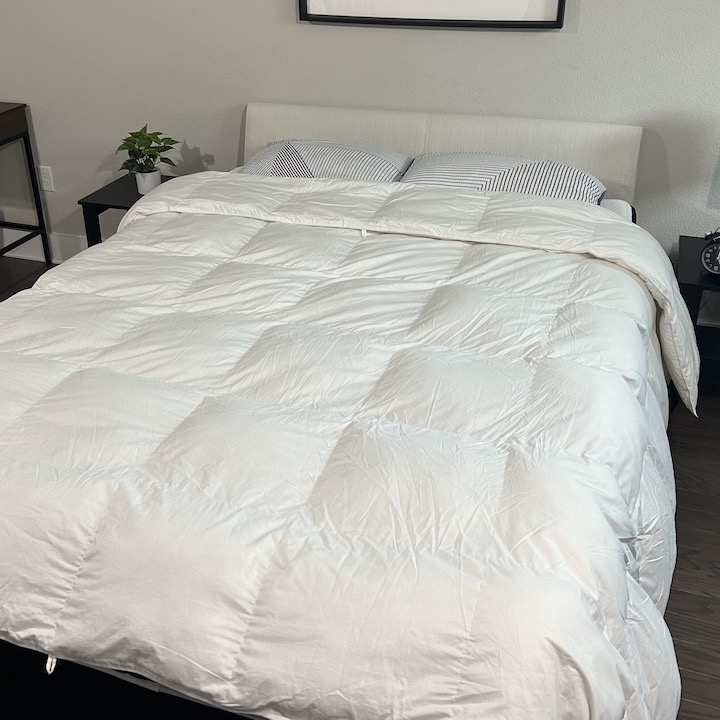
The LUXOME ClimaSense comforter actually senses your body temperature. When you get too hot, it will dissipate heat. But it also keeps you cozy when you’re cold.
Mattress Clarity Score
5.00 / 5
Our Expert’s Take
Comforters naturally add some extra warmth to your bed. But the best comforter is one that you can use without kicking it off while you sleep. The Luxome ClimaSense comforter has a unique material in it that keeps you at a perfect temperature. It’s called 37.5 active particle technology and it works by adapting to your body temperature. When you get too hot, the comforter will dissipate body heat.
It’s also great for keeping you nice and cozy. It features a baffle box design, meaning the cover is sewn through in a box design. This helps keep the inner fill evenly distributed and prevents lumping and clumping. This keeps the comforter fairly fluffy, even with continued use.
What our testers say: “37.5 technology is interesting. I didn’t really notice it working until I realized I wasn’t kicking off the ClimaSense comforter. Though it kept me cool, I found this comforter to feel a little too crisp, and it made noise when I shifted around.” – Tony Klespis, Reviewer
What We Love About the Luxome ClimaSense
- The Luxome ClimaSense is made with advanced cooling technology to regulate your body temperature all year-round.
- Its baffle box construction keeps the down alternative fill from moving around or clumping up.
- This comforter doubles as a duvet insert with loops in each corner to keep it in place.
What to Keep in Mind About the Luxome ClimaSense
- This comforter cannot be machine-washed, but adding a duvet cover can help prevent spills from staining the comforter.
- Its cover has a slightly crisp feel, and you might hear some crinkling as you shift it around.
Read our full Luxome ClimaSense Comforter review.
Best Down Alternative – Saatva Down Alternative
Saatva All-Year Down Alternative Comforter
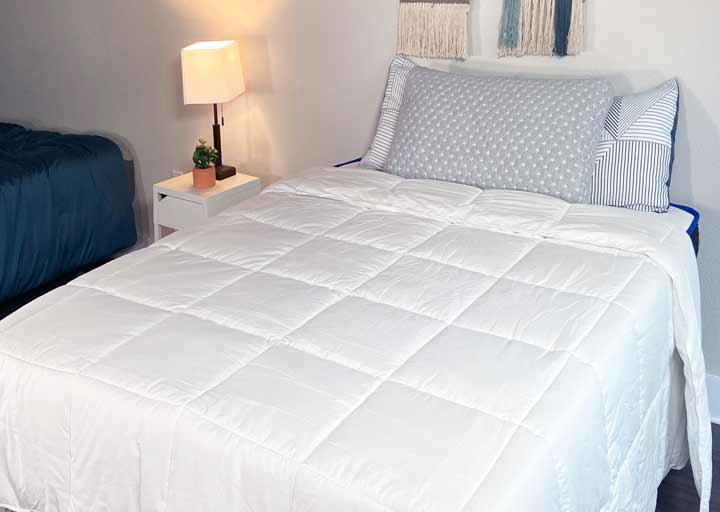
This down alternative comforter is made with organic cotton and cloud-like and hypoallergenic down alternative.
Mattress Clarity Score
5.00 / 5
Our Expert’s Take
These days many brands will make comforters in different warmth options to make sure there’s something for everyone. The Saatva Down Alternative comforter is one of the most comfortable comforters I’ve used, and it comes in three different warmth options. But no matter what option you pick, you’ll sleep very comfortably.
This comforter features a 100% cotton cover that uses a baffle box design to keep the down alternative fill evenly distributed. This design helps it stay nice and fluffy. The cotton is soft, but breathable. It just feels like a comforter should.
What our testers say: “Saatva makes you feel like you’re sleeping in a luxury hotel at home. The all-season Saatva comforter feels super plush and cozy. I personally run a little too hot to use it year round, but it certainly came in handy during cold months.” – Tony Klespis, Reviewer
What We Love About the Saatva Down Alternative
- Saatva offers three different comforter models in three warmth options: lightweight, all-season, and heavyweight.
- Its fluffy down alternative filling is also made with moisture-wicking lyocell. All three models are temperature-regulating and breathable.
- This comforter is made from ethically-sourced and recycled materials which are also hypoallergenic.
What to Keep in Mind About the Saatva Down Alternative
- Saatva is known for its high-end mattresses and bedding products, and its comforter may be too pricey for some customers.
- Its cover has a 200 thread count, which makes it ultra-breathable but less soft. Keep in mind that thread count is not an indicator of overall quality.
Read our full Saatva Down Alternative comforter review.
Best Down – Brooklinen Down Comforter
Brooklinen Down Comforter
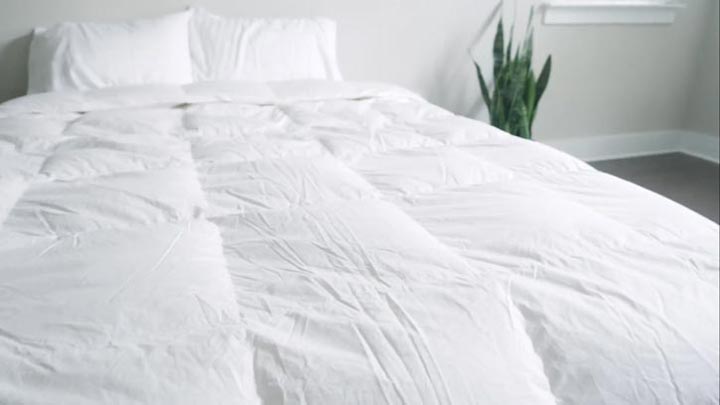
The Brooklinen Down Comforter is a great option for hot sleepers who love to sleep with a comforter. The down has tons of room for airflow, and the cotton shell is very breathable. There’s a warmth option for everyone with three to choose from. It’s one of our best comforters!
Mattress Clarity Score
4.70 / 5
Our Expert’s Take
Brooklinen is all about giving customers the best bedding. And if you love down products, then the Brooklinen Down comforter is one to look at. The company sources ethically harvested down from farms in Canada. This means that the feathers do not come from live animals.
Down is great because it offers natural insulation and creates a cozy environment. But thanks to a breathable cotton cover, and the space between the feathers, you shouldn’t feel like you’re going to overheat. But even if you are worried about overheating, Brooklinen offers this in three warmth options: lightweight, all-season and ultra warm, so there’s something for everyone.
What our testers say: “With three warmth options, the Brooklinen Down comforter has something for all down lovers. I tested the all-season model and you just feel plush comfort all around. If you like down products, you’ll be able to sleep at a comfortable temperature.” – Marten Carlson, Lead Reviewer
What We Love About the Brooklinen Down Comforter
- Some down comforters can trap allergens, but this down comforter is completely hypoallergenic and ideal for sleepers looking for anti-allergy bedding.
- Its cover is made with cotton-sateen and has a soft, satin-like feel.
- Its baffle box construction keeps its plush filling evenly distributed throughout.
What to Keep in Mind About the Brooklinen Down Comforter
- The lightweight and all-season models of this comforter don’t retain much warmth. If you are looking for a comforter to keep you extra cozy and warm, opt for the ultra-warm model.
- This comforter can only be spot-cleaned or dry-cleaned. Using a duvet cover can extend the life of your comforter and protect it from stains.
Read our full Brooklinen Down comforter review.
Best All-Season – Layla
Layla Comforter
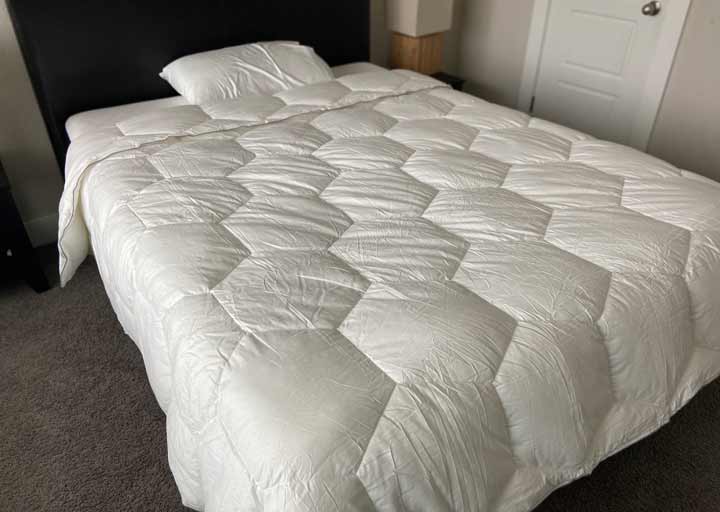
Layla Sleep is known for memory foam beds with its signature hexagon patterns. You’ll find this shape in all of its bedding products, and its comforter is no different. If you’re looking for a soft cotton comforter that also features a down alternative fill, then this is the comforter for you.
Mattress Clarity Score
4.70 / 5
Our Expert’s Take
Some people prefer to sleep with comforters year-round and use them over sheets. I used to prefer sleeping like this, and using an all-season comforter is key if you fall in the same category. Layla sells just one comforter in one warmth option: all-season.
This comforter is great for year-round use because it’s not super thick, but it’s not lightweight either. This comforter doesn’t offer anything specific in terms of cooling, but the cotton cover is breathable and allows for airflow. The signature Layla hexagon grid is a unique take on a baffle box design, but just like the baffle box, it helps keep the fluff evenly distributed.
What our testers say: “if you want something fluffy, but not super thick, the Layla comforter is that perfect middle ground. Personally, I run a little too hot to use this year round—really, the only cooling feature is just a breathable cotton cover. But this certainly works if you don’t find yourself getting hot quickly, or need something to bundle up with all year.” – Tony Klespis, Reviewer
What We Love About the Layla
- Layla has developed a down alternative material called “Cluster-Loft Down” that mimics the plushness of down feathers without using any animal products.
- The Layla comforter is easy to clean and maintain. You can put it in a washing machine with cold water and in the dryer on a low heat setting.
- This comforter is OEKO-Tex® certified, which means it is produced without any harmful chemicals.
What to Keep in Mind About the Layla
- Some very hot sleepers might feel overheated sleeping with the Layla comforter in warmer months of the year.
- Layla does not offer this comforter in different warmth options like some other brands.
Read our full Layla comforter review.
Best Bamboo – Cozy Earth Comforter
Cozy Earth Comforter
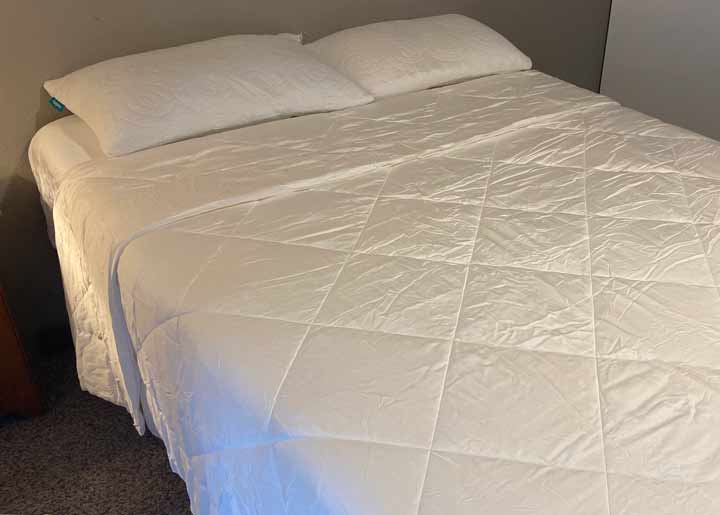
Cozy Earth is known for creating temperature regulating sleep products that keep you cool all night long, and the Cozy Earth Bamboo sheets are no exception. Not only will these sheets help you sleep cool, they are also some of the softest sheets on the market.
Mattress Clarity Score
4.90 / 5
Our Expert’s Take
High-quality bamboo viscose is luxuriously silky to the touch. Cozy Earth’s comforter comes with two different fill materials, silk and bamboo. For now, let’s focus on the bamboo fill. You can opt for a standard warmth or an extra-warm option. The standard is fairly flat, making it lightweight, but it still offers a cozy feeling when you rest with it.
Cozy Earth uses a direct supply chain for this bamboo, meaning the company is involved in every step of the production process. And bamboo is known for its cooling properties, so with the combination of a lightweight and cooling feel, hot sleepers should be able to enjoy this comforter.
What our testers say: “If you’re in the mood to splurge on the best bamboo bedding, I can’t recommend Cozy Earth enough. For a hot sleeper like me, the standard warmth bamboo fill comforter was perfect. Even though it was the ‘standard’ warmth, this was on the thin side. But that really worked well for me and I didn’t overheat using it.” – Tony Klespis, Reviewer
What We Love About the Cozy Earth Comforter
- Bamboo is a naturally hypoallergenic material, and is a good fit for sleepers with sensitive allergies.
- Its cooling properties and lightweight feel make it ideal for hot sleepers to use year-round.
- It comes with an impressive 10-year warranty that covers pilling and workmanship defects.
What to Keep in Mind About the Cozy Earth Comforter
- This high-end comforter is sold at a price point that may be out of some shopper’s budgets.
- It is not as fluffy as comforters with down or down alternative fillings.
Read our full Cozy Earth comforter review.
Best Lightweight – Buffy Cloud
Buffy Cloud Comforter
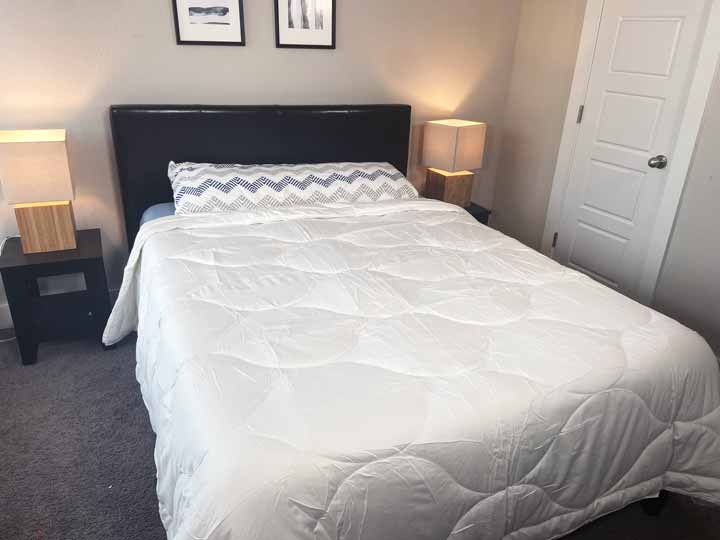
The Buffy is an eco-friendly comforter that features technology to fight overheating.
Mattress Clarity Score
4.80 / 5
Our Expert’s Take
The Buffy Cloud comforter is equal parts fluffy and lightweight. And it’s packed full with eco-friendly materials that don’t trap heat. The outer cover of the Buffy Cloud is made with Tencel lyocell. This fabric is moisture-wicking, breathable and cool to the touch. This gives it a soft, light feeling and it’ll feel much different than your standard cotton fabric.
The inside is full of a down alternative that is made from recycled plastic bottles. It does a good job at staying fluffy, but this isn’t a heavy material. Sleeping with the Buffy Cloud will feel cozy, but not uncomfortably hot.
What our testers say: “The Buffy Cloud really does feel soft and cloud-like. The Tencel outer cover is soft, cool-to-the-touch and helped me stay at a comfortable temperature. I didn’t really feel like I was using a super thick and heavy comforter.” – Tony Klespis, Reviewer
What We Love About the Buffy Cloud
- Its Tencel cover is cool to the touch and temperature-regulating, so it’s a good fit for hot sleepers to use year-round.
- The Buffy Cloud’s down alternative filling is made from recycled water bottles, so you’ll be saving the planet while sleeping comfortably!
- It can act as a duvet insert with loops in every corner.
What to Keep in Mind About the Buffy Cloud
- The Buffy Cloud comforter is not as fluffy or thick as other comforters. If you live in a very cold climate, you may want to consider an ultra-warm comforter.
- This comforter’s warranty term is only 50 days. Buffy accepts returns after the 50-day period on a case-by-case basis.
Read our full Buffy Cloud comforter review.
Best Luxury – Nest Silk Cloud Comforter
Nest Bedding Silk Cloud Comforter
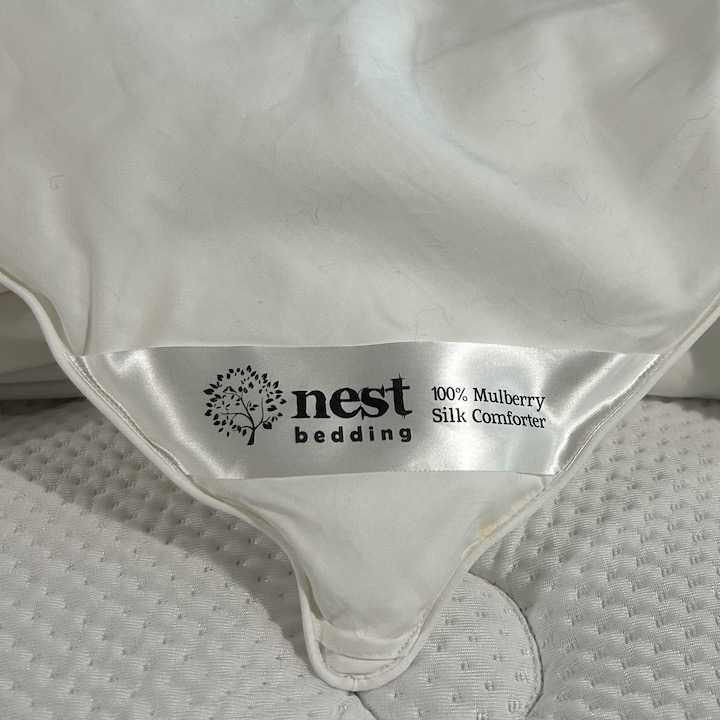
The Nest Bedding Silk Cloud comforter combines cotton and silk to give a soft, luxurious sleeping experience.
Mattress Clarity Score
4.70 / 5
Our Expert’s Take
Sometimes luxury products are worth the splurge. Nest uses 100% Mulberry silk inside its Silk Cloud comforter to offer a truly luxurious sleep experience. This silk fiber fill is encased in a cotton cover that has been woven into a sateen weave. This gives the cotton a soft, satin-like feeling, which helps sell that luxury experience.
Silk is actually a good material for hot sleepers, too. It’s very breathable, and this is another comforter that’s not outrageously thick. It still offers some nice coziness, but you likely won’t have to worry about overheating. It only comes in white, but it can act as a duvet insert to help protect it from stains or discoloration.
What our testers say: “Silk is always super luxurious. And while I expect it more as a cover material, the silk fiber fill is really soft. I was surprised to see that the cover wasn’t sewn through with a baffle box, but the fill stays in place. Really, the only downside here is that you can’t machine wash this comforter.” – Tony Klespis, Reviewer
What We Love About the Nest Silk Cloud Comforter
- Its sateen-weave cotton cover is super soft, breathable, and has a luxurious, satin-like finish.
- The Nest Silk Cloud comforter is fairly lightweight, which could make it a good match for hot sleepers looking for an all-season comforter.
- This comforter is made from 100% natural and eco-friendly materials.
What to Keep in Mind About the Nest Silk Cloud Comforter
- This comforter is not as fluffy as a down or down alternative comforter.
- Nest suggests sleepers spot clean or dry clean their comforter only. Putting it in the washing machine or dryer is not recommended.
Read our full Nest Silk Cloud comforter review.
Best Fluffy – Puffy
Puffy Deluxe Comforter
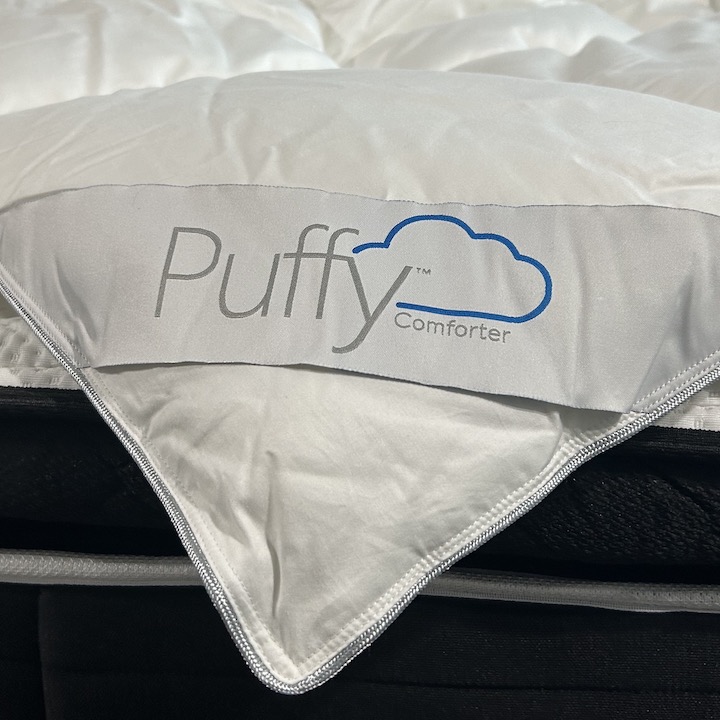
The Puffy Comforter is like wrapping yourself up with a cloud. It’s soft, fluffy, and provides a perfect amount of coziness.
Mattress Clarity Score
5.00 / 5
Our Expert’s Take
Some comforters can fall flat, but Puffy’s comforter stays fluffy year-round. It features a baffle box construction in the polyester cover to keep the inner fill evenly distributed. Puffy even mentions that this down alternative fill material is designed to resist clumping and lumping. So this means, in combination with the baffle box design, it will stay fluffy.
Puffy is all about selling that “cloud-like” comfort, and the same is true for this comforter. It is like sleeping with a fluffy cloud. It should even retain this fluffiness after being washed. That’s another huge perk for this comforter: it’s machine-washable. It does only come in white, but if you’re looking to add a splash of color, you can use this as a duvet insert, too.
What our testers say: “No one does fluffy like Puffy. Right out of the packaging, this comforter puffed up and was ready to be used for a comforter burrito. Puffy does mention breathable materials, but as a hot sleeper, I can’t really see myself using this unless it’s cold outside. But it’ll be all I need for those cold months, that’s for sure.” – Tony Klespis, Reviewer
What We Love About the Puffy
- Its baffle-box construction keeps its microfiber fill evenly distributed and extra fluffy.
- Puffy offers customers a 101-night sleep trial to decide whether the comforter is a good match or not. Puffy also offers customers a lifetime warranty which covers manufacturing defects.
- It’s made with hypoallergenic materials to prevent dust and allergens from collecting in your bed.
What to Keep in Mind About the Puffy
- The Puffy comforter comes with no advanced cooling features. If you are a hot sleeper, you may find yourself getting too warm under this comforter in the summer.
- This comforter is only available in one all-season warmth option.
What Should People Consider When Buying a Comforter?
A comforter is not quite the investment that a mattress is, but no one wants to go through the process of buying and returning an unfit comforter. Keep the following criteria in mind, and it should not be difficult to track down the right comforter.
Warmth and Breathability
Comforters are known for keeping you warm. You should consider how much warmth you need. Are you a hot sleeper or will you be using this comforter during winter or summer? If you need a summer comforter, a very lightweight down alternative comforter could work.
Down is usually more insulating than most alternatives and, because of this, one needs more down alternative filling to equal the warmth of down. Basically, down comforters can be lighter and still offer a good amount of warmth.
Down is also more breathable than alternatives like polyester or down alternative comforters, which may make people get clammy or sweaty while they sleep. Down is both warm and breathable at the same time.
Down vs Down Alternative
When it comes to the comforter’s fill, the main choice customers have to make is between down and down alternative.
Down is taken from underneath the feathers of ducks and geese and is a natural insulating material. Down alternative filling is made from synthetic materials (such as polyester) or other natural materials (such as cotton).
Down is usually more expensive than an alternative option. I’ll touch on more specific benefits and drawbacks associated with each type of comforter in the following sections.
RELATED: Duvets vs Comforters

Fill Power
When shopping for a comforter, people will undoubtedly come across the term “fill power.” This is basically a measurement of loft. More specifically, it measures how much space one ounce of down fills at full expansion. The higher the fill power, the greater the loft; anything from 500 to 750 is considered good fill power and over 750 is excellent.

You also need to consider the amount of fill in a comforter to really understand how lofty it will be. For instance, an 800 fill power comforter with only 30 ounces of filling could be less lofty than a 700 fill power comforter with 60 ounces of filling.
You may also see down alternative comforters with an advertised fill power, but it is very difficult to compare the fill power of polyester to that of down. They have different properties, so be careful when judging the fill power of down alternative comforters.
Construction
Two other terms shoppers will come across are “sewn-through” and “baffle box.” These refer to the way the filling is sewn into the comforter. Sewn-through is when the two sides of the comforter are sewn directly together, and the down or synthetic fill is held in an almost two-dimensional square. A baffle box is created when an extra piece of fabric is sewn between the two sides of the comforter which creates a three-dimensional space for the fill.
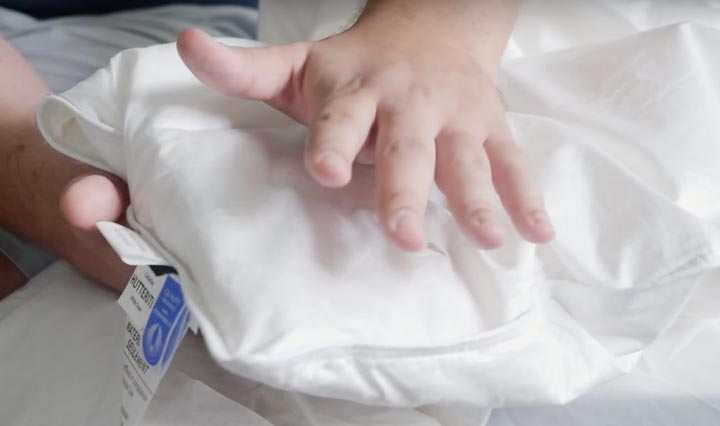
With a baffle box construction, there is more room for the fill to fully expand. Even if a comforter has a high fill power, it is important to make sure it can reach its maximum loft. As a general rule, baffle box construction allows for greater loft.
RELATED: Sewn-Through vs Baffle Box Comforters
Allergies
While down comforters are usually superior in warmth and fluffiness, they do have issues when it comes to allergies. Down easily traps allergens such as dust mites and pollen, while down alternative does not have this problem.
You’ll see down comforters with hypoallergenic covers that are meant to stop dust and pollen from moving into the fill. Other down comforters advertise that their fill has been washed many times, but this is still not as reliable as a comforter with synthetic fill.
Those who struggle with severe allergies might consider a down alternative comforter.
RELATED: How to Wash a Comforter
Summary
Once again, here is our list of the best comforters on the market.
| Comforter | Best For |
| Luxome ClimaSense | Best Overall |
| Saatva Down Alternative Comforter | Best Down Alternative Comforter |
| Brooklinen Down Comforter | Best Down Comforter |
| Layla Comforter | Best All-Season Comforter |
| Cozy Earth Comforter | Best Bamboo Comforter |
| Buffy Cloud Comforter | Best Lightweight Comforter |
| Nest Silk Cloud Comforter | Best Luxury Comforter |
| Puffy Comforter | Best Fluffy Comforter |
Buying a comforter doesn’t have to be a chore and, considering the information above, it shouldn’t be difficult to find the right comforter! If customers consider the temperature of the bedroom, budget, and other preferences, they should be sleeping under a cloud in no time.
The Best Comforters FAQs
What is the best type of comforter?
This really depends on what someone is looking for; those who struggle with allergies and want to spend less money should consider a down alternative comforter. Those who prefer a fluffier and warmer comforter with more breathability should take a look at down.
What is the best down comforter?
Our best down comforter is the Brooklinen Down comforter. It is full of ethically sourced down and it is encased in a soft, breathable cotton shell. It also comes in three warmth options so there’s something for everyone.
What’s the best down alternative comforter?
There are a number of down alternative comforters on this list, but my personal favorite is the Saatva Down Alternative comforter. It’s soft, fluffy, and kept me at the perfect temperature.
How do I choose a good down comforter?
In order to find a good down comforter, consider a few things: find a comforter with a high fill power and heavy fill weight. This will ensure that the down comforter is on the fluffier side.
Also, look at what the fill of the comforter is: is it a high-end goose down or something else? Finally, find a comforter with a baffle box construction, as this will allow the fill to full expand.


